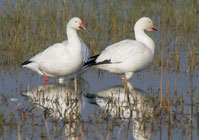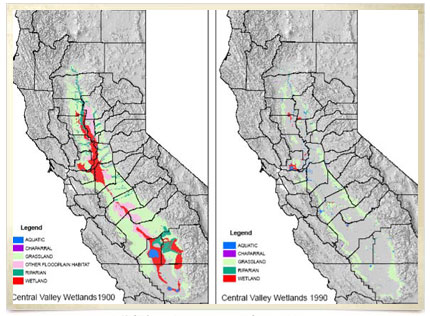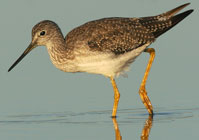Accomplishments
The CVJV partnership has earned an impressive record of accomplishment since its inception in 1988, and is making great progress towards meeting the objectives identified in its 2020 Implementation Plan.

 Cinnamon Teal
Cinnamon TealOur Mission
The mission of the Central Valley Joint Venture is to work collaboratively through diverse partnerships to protect, restore, and enhance wetlands and associated habitats for waterfowl, shorebirds, waterbirds, and riparian songbirds, in accordance with the conservation actions identified in the Joint Venture's Implementation Plan.
Who we are
The Central Valley Joint Venture has its origins in the North American Waterfowl Management Plan (NAWMP), an international treaty signed by Canada, the United States and Mexico. The NAWMP was a direct response to declining numbers of North American waterfowl. It established population goals for key waterfowl species, and identified a framework for recovering these populations through habitat enhancement, restoration and protection. Although the goals of the NAWMP were continental in scope, the plan’s success ultimately depended on regional efforts to increase waterfowl habitat. The joint venture concept of merging the efforts of government agencies, non-profit organizations, corporations, tribes, and individuals was ideally suited to the task of meeting waterfowl needs at regional scales. As a result, joint ventures were eventually formed in all of North America’s key waterfowl areas to meet NAWMP goals.
The Central Valley Habitat Joint Venture was formally organized in 1988 and was one of the original six priority joint ventures formed under the NAWMP. Renamed the Central Valley Joint Venture in 2004, the Management Board now consists of nineteen public and private members.
The CVJV is currently administered through a coordination office within the U.S. Fish and Wildlife Service, and is guided by a Management Board that receives input and recommendations from a variety of working committees.
 History of Central Valley Wetlands
History of Central Valley Wetlands
The CVJV partnership has earned an impressive record of accomplishment since its inception in 1988, and is making great progress towards meeting the objectives identified in its 2020 Implementation Plan.

Follow these links to learn about some of the important bird conservation work happening in California's Central Valley.
